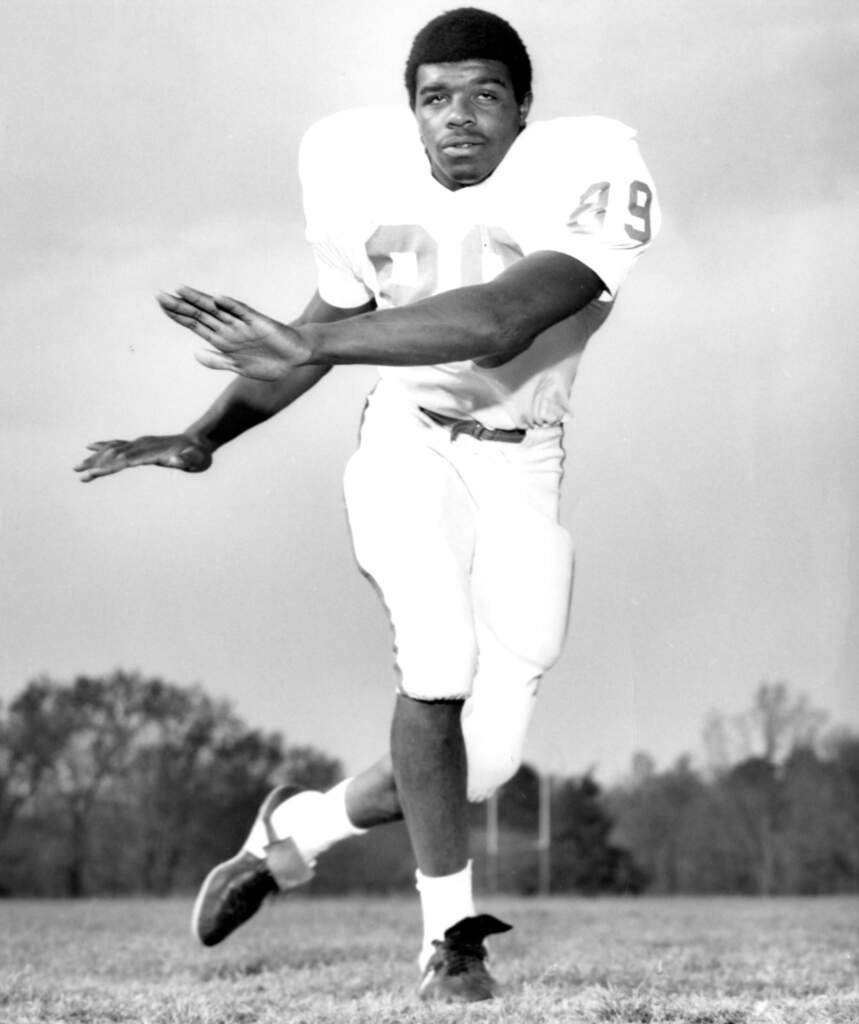Sept. 3, 2010
Clemson people largely have a hard time blending in with the crowd in public settings. It could be because of the shade of orange associated with the university, or because of the unique design of the Clemson ring that makes it so discernible, especially for fellow graduates.
But arguably the most easily-recognizable symbol of Clemson is the Tiger Paw logo, one of the most recognizable symbols in collegiate athletics. Over many years, the Paw has become synonymous with Clemson Tiger athletics and has stood for excellence and pride among students, faculty, alumni, and fans around the globe.
Many people may assume that the Paw is as old as the hills on which the university rests, but that is simply not the case. In fact, the idea is relatively new, as the Clemson Tiger Paw turned 40 years old in July. Over the past four decades, the Paw has become woven into the fabric of Clemson culture and is arguably the most direct link between the university and the outside world.
The Paw began as an idea to set Clemson athletics apart from the crowd, but it now serves a much greater function, as it has become a quasi-ambassador for the university’s overall mission to people around the world. The Paw embodies the Clemson spirit and symbolizes the values that hold the university together.
During the 1950s, wholesale changes began to take place around Clemson. The university, among other things, began to admit women and minorities, dissolved the Corps of Cadets, and re-organized the administration – all in an effort to alter the image of the school at the behest of an independent company that was brought in to complete an audit of the entire school.
It was toward the tail end of this rebranding process, in 1969, that rumblings began about changing the logo from the traditional tiger to something more original. A committee was formed to investigate a new logo and to direct the development of such a change. Members included Athletic Director Frank Howard, Assistant Athletic Director Bill McLellan, and Head Football Coach Hootie Ingram, who some suggest was the driving force behind the shift to the Paw.
The committee enlisted the services of the Henderson Advertising Agency in Greenville, SC to come up with the design and complete the transition to a new logo. The owner of the company, James M. Henderson, was a 1944 Clemson graduate who took the job despite the understanding that compensation would be minimal. He and his vice president, Fred Walker, took the lead in making sure the situation was handled with the utmost care and urgency.
After discussing several options, it was decided that the Tiger Paw would be considered for the new logo. The agency turned the project over to creative designer and artist John Antonio in June of 1970 to begin the drafting process, which took several days.
He contacted the Smithsonian Institute for a photo of a tiger’s paw and the National History Museum in Chicago, IL for a cast of a tiger paw. He used both items in forming his final version of the Clemson Tiger Paw.
When he was finished, Antonio presented the completed project to a group of athletic department personnel, who were largely receptive to the Tiger Paw design. Apparently, the key to the presentation of the project was Antonio showing the Tiger Paw on a football helmet. Howard thought it looked sharp and he was on board with the overall idea. Then the Paw was successfully pitched to Dr. R.C. Edwards, who was president of Clemson at the time, and it was also presented to the Board of Trustees.
Some of the intricacies of the Paw that contribute to its aura were implemented by design at the behest of Antonio. The 30-degree angle at which the official Paw sits is there to designate a 1:00 kickoff time for football games, which was a normal occurrence in those days. The indention at the bottom is due to a scar that the tiger who had been chosen as the subject for the logo had received before the cast was made.
Once the decision was made by Howard to adopt the Tiger Paw design as Clemson’s official athletic logo, several individuals were deployed to various locations in the southeast to present the idea to students, alumni, and the general public. Initially, the reviews were mixed.
“When they came back with the idea and said we were going to use it, some people were apprehensive about it,” said former IPTAY Executive Director George Bennett. “But some people were overjoyed with it, and eventually, people got really excited.”
Due to the continued efforts of media members and athletic brass promoting it, Clemson’s fanbase became more accepting of the new insignia of the university’s athletic programs within a short period of time. The Paw began to pop up on various merchandise and sales steadily rose as fans accepted it as part of the Clemson culture.
It was not long before the increasing popularity of the Paw became a problem for the athletic administration. After the football team won the 1981 national title, individuals and corporations showed interest in copying the Paw for personal use. For a few years, Clemson granted many of these requests before realizing the need to license the Tiger Paw and make it the property of the university alone.
“In the very beginning, we didn’t want it to be licensed because we wanted people to use it,” admitted Bennett. “I don’t think anyone even thought about copyrighting and licensing it. But what we didn’t realize was going to happen was that every school in the country that had some kind of animal would start using it. Someone said that the best form of success is how many times you get copied. The Paw is pretty successful.”
Licensing was first suggested by Henderson when his company designed the Paw, but the university was hesitant to go that route because of a lack of precedent elsewhere in the country, the fact that the university had never copyrighted anything before, and the tedious and costly process that it would entail.
Eventually, the allure of being able to control the usage and the profits associated with the Tiger Paw logo appealed to enough people within the athletic department that steps were taken toward giving Clemson exclusive rights. In 1982, McLellan and Sports Promotions Director Allison Dalton explored options for copyrighting the logo.
They identified Collegiate Concepts, a newly-formed company specifically designed to administer licenses and copyrights for institutions of higher learning. Discussions continued for several months with Bill Battle from Collegiate Concepts, a former head coach at Tennessee, McLellan, and Dalton. Then in June of 1984, the Clemson Tiger Paw was officially trademarked by the federal government, along with several other monikers and secondary logos. Clemson became the third institution to use Collegiate Concepts, now known as the Collegiate Licensing Company (CLC), behind Alabama and Mississippi.
“In those early years of licensing, the focus was on educating companies as to why they had to be licensed and getting those companies to use the Tiger Paw on approved merchandise,” said Derek Eiler, senior vice president and managing director of CLC. “The business has evolved dramatically over the past two decades. Now, it is our job to partner with the university to protect, manage, and develop the brand to ensure the value of the Tiger Paw is maximized for Clemson.”
As the Clemson Tiger Paw approaches four decades of existence, it appears that its value has continued to grow. Focused advertising strategies, such as the Solid Orange campaign, have increased exposure to the Paw around the country, and the brand remains as strong as ever.
Knowing the history of the Clemson Tiger Paw, it becomes nearly impossible to see it as simply a painting on the 50-yard line, a lapel pin, or a way to decorate Clemson’s apparel. Because of the efforts of so many throughout the years, the Paw has become a way to display the spirit of Clemson University – a place that is as unique as the symbol that best signifies it.
 Duke
Duke 
 Florida State
Florida State  Louisville
Louisville  Furman
Furman  South Carolina
South Carolina  LSU
LSU  Troy
Troy  Georgia Tech
Georgia Tech  Syracuse
Syracuse  North Carolina
North Carolina  Boston College
Boston College  SMU
SMU 






